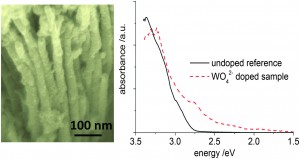TiO2 nanotubes demonstrate photocatalytic properties that make them useful in applications such as decomposition of organic pollutants. These nanotubes are commonly grown in an anodization process that takes place in an electrolytic bath, with dopants, which are used to modify the catalytic properties of the nanotubes, added at a later stage.
In this paper, Hahn and co-workers have demonstrated a new growth method in which the desired dopants are dissolved in the electrolyte solution. The nanotubes grown from this solution incorporate the dopants, and no further treatment is required. A test of the photocatalytic properties of the nanotubes also confirms that it behaves very similar to nanotubes grown by conventional methods. This fast and convenient way of manufacturing doped TiO2 nanotubes opens the route to many potential future applications.
Find out more by reading the full article:
Photocatalytic properties of in situ doped TiO2-nanotubes grown by rapid breakdown anodization
Robert Hahn, Martin Stark, Manuela Sonja Killian and Patrik Schmuki
Catal. Sci. Technol., 2013, Advance Article
DOI: 10.1039/C3CY00021D











